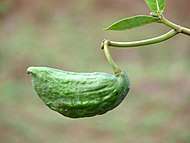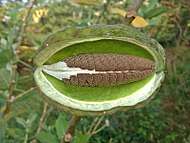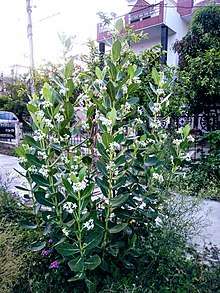Calotropis gigantea
| Calotropis gigantea | |
|---|---|
 | |
| Scientific classification | |
| Kingdom: | Plantae |
| (unranked): | Angiosperms |
| (unranked): | Eudicots |
| (unranked): | Asterids |
| Order: | Gentianales |
| Family: | Apocynaceae |
| Subfamily: | Asclepiadoideae |
| Genus: | Calotropis |
| Species: | C. gigantea |
| Binomial name | |
| Calotropis gigantea (L.) Dryand.
| |


Calotropis gigantea (crown flower) is a species of Calotropis native to Cambodia, Indonesia, Malaysia, the Philippines, Thailand, Sri Lanka, India, China, Pakistan, Nepal, Booc Booc in Somalia and tropical Africa.[1]
It is a large shrub growing to 4 m (13 ft) tall. It has clusters of waxy flowers that are either white or lavender in colour. Each flower consists of five pointed petals and a small "crown" rising from the center which holds the stamens. The aestivation found in calotropis is valvate i.e. sepals or petals in a whorl just touch one another at the margin, without overlapping. The plant has oval, light green leaves and milky stem. The latex of Calotropis gigantea contains cardiac glycosides, fatty acids, and calcium oxalate.
Pollination
This plant plays host to a variety of in Tamil Nadu and butterflies. It is the host plant for Hawaii's non-migratory monarch butterflies.[2] Calotropis is an example of entomophily pollination (pollination by insects) and pollination is achieved with the help of bees. In Calotropis, gynostegium is present (formed by the fusion of stigma and androecium). The pollen are in a structure named pollinia which is attached to a glandular, adhesive disc at the stigmatic angle (translator mechanism). These sticky discs get attached to the legs of visiting bees that pull out pollinia when a bee moves away. When such a bee visits another flower, this flower might be pollinated by the pollinium.

Uses
The flowers are long lasting, and in Thailand they are used in floral arrangements. The extract of flowers and leaves has shown hypoglycemic effect in preclinical studies.[3] They were favored by the Hawaiian Queen Liliuokalani, who considered them a symbol of royalty and wore them strung into leis. In Cambodia, they are used in funerals to decorate the urn or sarcophagus and the interior of the house holding the funeral. The fruit is a follicle and when dry, seed dispersal is by wind. In Indonesia its flowers are called widuri. According to Shivpuran (Hindu religion) the madar flower/crown flower is very much liked by Lord Shiva; therefore the crown flower and its garland are offered to Lord Shiva for peace, prosperity and stability in society.[4] The Crown flower is also one of the major parts of the nine astrological trees (Navagrah tree).
Calotropis yields a durable fiber (commercially known as bowstring of India) useful for ropes, carpets, fishing nets, and sewing thread. Floss, obtained from seeds, is used as stuffing. Crown flower cotton can also be used to make a pillow. A fermented mixture of Calotropis and salt is used to remove the hair from goat skins for production of nari leather and from sheep skins to make leather which is much used for inexpensive book binding.[5] Fungicidal and insecticidal properties of Calotropis have been reported.[6]
In India, the plant is common in the compounds of temples and is known as madar in Hindi: मदार. Its leaf (Marathi: rui) is one of the five leaves used in the Panch Pallava, a ritual assortment of five different leaves used as a totem by the Maratha culture in India.[7]
It is known as වරා (waraa) in Sinhala, আকন (akon) in Assamese, aakonda in Bengali, erukku (എരുക്ക്) in Malayalam, yakka (ಯಕ್ಕ) in Kannada, and ark (अर्क) in Sanskrit.
Allelopathic effects
Allelopathic effects of Calotropis on different agricultural crops have been well studied.[8] Extracts of plant parts such as root, stem, and leaf affect germination and seedling vigor of many agricultural crops.[9][10] However, extracts of Calotropis failed to produce any detrimental effects on weeds such as Chenopodium album, Melilotus alba, Melilotus indica, Sphaeranthus indicus, and Phalaris minor.[11]
Use as an Arrow Poison
Many plant and animal extracts have been used as arrow poisons all over the world. In many cases, the poison was applied to the arrow or spear to aid the hunting of prey. Alkaloids are among the most powerful plant poisons, and extracts of Strychnos species are commonly used. Other arrow poisons are commonly cardiac glycosides, which can be found in digitalis, but most of these arrow poisons are derived from plants in the Apocynaceae family.[12] This family includes Calotropis gigantea and the more potent Calotropis procera. The latex of these plants has been used in Africa as an arrow poison. Apocynaceae species often contain a mixture of cardiac glycosides, including calactin, uscharin, calotoxin, and calotropin.[13] These poisons work by inhibiting the sodium-potassium pump, and this effect is especially potent in the cardiac tissues.[14] The cardiac effects can be applied for heart medication, and digitalis has been used as such. However, excessive doses can cause arrhythmia, which can lead to death.[15]
Medical Uses
Given the potent bioactivity of calotropin, calotropis gigantea has been used as a folk medicine in India for many years, and has been reported to have a variety of uses. In Ayurveda, Indian practitioners have used the root and leaf of C. procera in asthma and shortness of breath and the bark in liver and spleen diseases. The plant is reported as effective in treating skin, digestive, respiratory, circulatory and neurological disorders and was used to treat fevers, elephantiasis, nausea, vomiting, and diarrhea. The milky juice of Calotropis procera was used against arthritis, cancer, and as an antidote for snake bite.[16] However, these reports are of folk uses and more research is needed to confirm the clinical usefulness of the leaves, latex, and bark. Recent studies have displayed use of calotropin as a contraceptive[17] and as a promising cancer medication.[18] In one study of the cancer-fighting properties of Calotropis gigantea, DCM extracts were demonstrated to be strongly cytotoxic against non-small cell lung carcinoma (A549), colon carcinoma (HCT 116), and hepatocellular carcinoma (Hep G2). These extracts show promise as cancer medications and warrant further clinical research.[19]
Poisoning
Calotropis is a poisonous plant. The active principles are uscharin, calotoxin, calactin, and calotropin. The leaves and stem when incised yield thick milky juice. It is used as an arrow poison, cattle poison (see also Sutari), rarely for suicide and homicide and mostly an accidental poison.
The milky latex sap of Calotropis gigantea is a known cause of toxic keratoconjunctivitis and reversible vision loss. Crownflower keratitis is a rare condition and is usually the result of accidental ocular exposure to the sap. During the process of making a Hawaiian lei flower necklace, touching the sap and then touching the ocular surface may result in crownflower keratitis. Damage (poisoning) of the cornea endothelium results in corneal stromal edema and decreased visual acuity. Although there is some permanent damage to the corneal endothelium with decreased endothelial cell count and irregular shape, the remaining corneal endothelial cells usually recover with complete resolution of the corneal edema and a return to normal visual acuity. The condition is usually self-limited and resolves faster with topical steroids. The clinical course of this condition suggests that Calotropis is paradoxically relatively nontoxic to corneal epithelium and highly toxic to corneal endothelium. The painless clinical course may be related to anesthetic properties of Calotropis latex and relatively minor epithelial injury.[20][21][22]
Signs and symptoms
Applied to the skin, it causes redness and vesication. When taken orally, the juice produces an acrid, bitter taste and burning pain in throat and stomach, salivation, stomatitis, vomiting, diarrhea, dilated pupils, tetanic convulsions, collapse and death. The fatal period is 6 to 12 hours. Treatment includes stomach wash, demulcents, and symptomatic treatment.
Mosquito controlling property
C. gigantea is reported to exhibit mosquito controlling properties against Culex gelidus and Culex tritaeniorhynchus mosquitoes which serve as vectors for Japanese encephalitis. The aqueous extract of the C. gigantea leaves demonstrated significant larvicidal, repellent and ovicidal activity.[23]
Literary references
In the Paushya chapter of the Adi Parva portion of the Indian epic Mahabharata, a disciple of the rishi Ayoda-Daumya named Upamanya goes blind by eating the leaves of the plant which in Sanskrit is called arka.
However, in India, among the general public, it is the belief that akada (arka) is a poisonous plant and can make people intoxicated. Lord Shiva is offered akada along with dhatura (botanically: Datura metel) (extremely toxic) flowers on auspicious days.
"श्वेतार्क का पेड" is the name of the tree and flowers are called as "अकौआ" ओर "श्वेतार्क के फूल" in Hindi respectively. It is the favourite plant of the Lord Shiva and hence its flowers are offered to the God for gaining God's blessings. By offering the flowers of this plant, Lord Shiva becomes very happy from his followers. It is commonly found in every state of India.
See also
References
- ↑ Bingtao Li; Michael G. Gilbert; W. Douglas Stevens, "Calotropis gigantea (Linnaeus) W. T. Aiton, Hortus Kew. ed. 2. 2: 78. 1811", Flora of China online, retrieved 19 July 2015
- ↑ Butterfly Society of Hawaii
- ↑ Rathod, Nanu R.; Chitme, Havagiray R.; Irchhaiya, Raghuveer; Chandra, Ramesh (25 March 2011). "Hypoglycemic Effect of Calotropis Gigantea Linn. Leaves and Flowers in Streptozotocin-Induced Diabetic Rats". Oman Medical Journal. 26 (2): 104–108. doi:10.5001/omj.2011.26. PMC 3191672. PMID 22043394.
- ↑ http://www.freepressjournal.in/weekend/mahashivaratri-favorite-plants-of-lord-shiva/798182
- ↑ Singh et al. 1996
- ↑ Ganapathy and Narayanasamy 1993
- ↑ Indian Trees
- ↑ Oudhia, P. (2002).Allelopathic potential of useful weed Calotropis gigantea R.Br: A review. In: Abstracts. Third World Congress on Allelopathy: Challenges for the New Millennium, National Institute for Agro-Environmental Sciences (NIAES), Tsukuba, Japan, Aug.26-30,2002:179.
- ↑ Oudhia and Tripathi 1997, 1999
- ↑ Oudhia et al. 1997, 1998a, b
- ↑ Oudhia and Tripathi 1997
- ↑ Philippe, Geneviève; Angenot, Luc (2005). "Recent developments in the field of arrow and dart poisons". Journal of Ethnopharmacology. 100 (1–2): 85–91. doi:10.1016/j.jep.2005.05.022. ISSN 0378-8741.
- ↑ 1949-, Daniel, M. (Mammen), (2006). Medicinal plants : chemistry and properties. Enfield, NH: Science Publishers. ISBN 1578083958. OCLC 61456768.
- ↑ Agrawal, Anurag A.; Petschenka, Georg; Bingham, Robin A.; Weber, Marjorie G.; Rasmann, Sergio (2012-01-31). "Toxic cardenolides: chemical ecology and coevolution of specialized plant-herbivore interactions". New Phytologist. 194 (1): 28–45. doi:10.1111/j.1469-8137.2011.04049.x. ISSN 0028-646X.
- ↑ Hoyer, Kirsten; Song, Yejia; Wang, Desuo; Phan, Dillon; Balschi, James; Ingwall, Joanne S.; Belardinelli, Luiz; Shryock, John C. (2011-05-01). "Reducing the Late Sodium Current Improves Cardiac Function during Sodium Pump Inhibition by Ouabain". Journal of Pharmacology and Experimental Therapeutics. 337 (2): 513–523. doi:10.1124/jpet.110.176776.
- ↑ Upadhyay RK. Ethnomedicinal, pharmaceutical and pesticidal uses of Calotropis procera (Aiton) (Family: Asclepiadaceae). Int J Green Pharm 2014;8:135-46.
- ↑ Sarma, Kishore; Roychoudhury, Shubhadeep; Bora, Sudipta; Dehury, Budheswar; Parida, Pratap; Das, Saurav; Das, Robin; Dohutia, Chandrajit; Nath, Sangeeta (2017-03-23). "Molecular Modeling and Dynamics Simulation Analysis of KATNAL1 for Identification of Novel Inhibitor of Sperm Maturation". Combinatorial Chemistry & High Throughput Screening. 20 (1): 82–92. doi:10.2174/1386207320666170116120104. ISSN 1386-2073.
- ↑ Wang, Shih-Chung; Lu, Mei-Chin; Chen, Hsiu-Lin; Tseng, Hsing-I; Ke, Yu-Yuan; Wu, Yang-Chang; Yang, Pei-Yu (2009). "Cytotoxicity of calotropin is through caspase activation and downregulation of anti-apoptotic proteins in K562 cells". Cell Biology International. 33 (12): 1230–1236. doi:10.1016/j.cellbi.2009.08.013. ISSN 1065-6995.
- ↑ Jacinto, S.D.; Chun, E.A.C.; Montuno, A.S.; Shen, C.C.; Espineli, D.L.; Ragasa, C.Y. (2011). "Cytotoxic Cardenolide and Sterols from Calotropis gigantea". Natural Product Communications. 6 (6): 803–806.
- ↑ Wong, W. H.: Crownflower keratoconjunctivitis, Hawaii Med J. 1949;8:339-341.
- ↑ Crawford, H. E. : Crownflower Keratoconjunctivitis, Hawaii Med J. 1958;17:244-245
- ↑ Hani S. Al-Mezaine, Ali A. Al-Rajhi, Abdullah Al-Assiri, Michael D. Wagoner, Calotropis procera (ushaar) keratitis, American Journal of Ophthalmology, Volume 139, Issue 1, January 2005, Pages 199-202
- ↑ Kumar G, Karthik L, Rao KVB, Karti AV, Rahuman AA, Larvicidal, Repellent and Ovicidal activity of Calotropis gigentia against Culex tritaeniorhynchus and Culex gelidus. Journal of Agricultural Technology, 2012, 8(3): 869-880
External links
| Wikimedia Commons has media related to Calotropis gigantea. |
| Wikispecies has information related to Calotropis gigantea |
- PIER - Calotropis gigantea
- Flowers of India - Crown flower
- Purdue University: Center for New Crops & Plant Products - Crown flower
- Dressler, S.; Schmidt, M. & Zizka, G. (2014). "Calotropis gigantea". African plants – a Photo Guide. Frankfurt/Main: Forschungsinstitut Senckenberg.